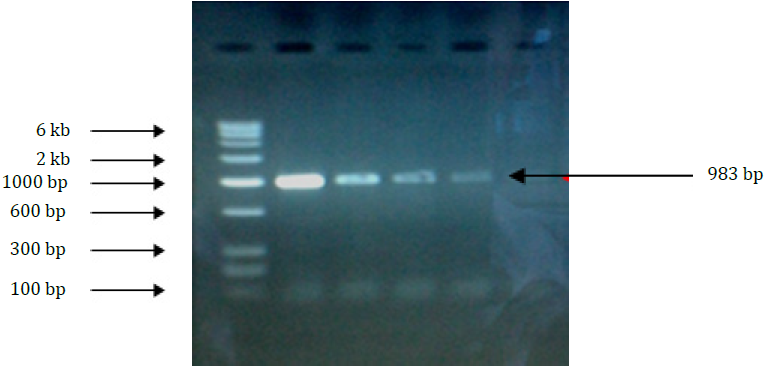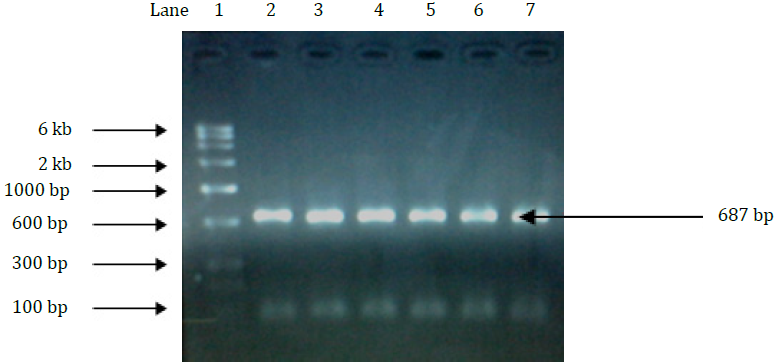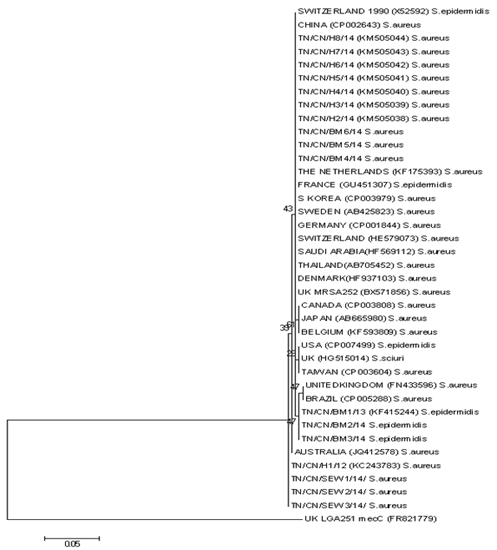Short Communication
Volume 1 Issue 3 - 2017
Identification and Analysis of MRSA Isolated From Sources of Clinical, Milk and Sewage Samples Collected In Chennai
1Chettinad Academy of Research and Education, Kelambakkam, India
2Madras Veterinary College, Chennai, India
2Madras Veterinary College, Chennai, India
*Corresponding Author: G. Sathish, Madras Veterinary College, Chennai, India.
Received: September 27, 2017; Published: October 16, 2017
Abstract
Methicillin Resistant staphylococcus aureus is a common problem at the community level worldwide. India like countries which are not having standard quality control measurements and poor hygiene, are the major sufferer. Hence the protocols should be applied to monitor antibiotic resistance in all media like clinics and waste water for better control. Here in this study samples from our hospital clinical, milk of suspected from bovine mastitis cases and wastewater bodies were surveyed for MRSA by PCR and sequencing. Phylogenetic analysis of mecA gene revealed the strong relationship between clinical, milk and waste water isolates through mobile genetic transfer. So the results exhibiting high proportions of MRSA in all the three categories, urging better city and town planning.
Keywords: MRSA; PCR; Sequencing; Phylogenetic tree; Clinical; Wastewater; Milk
Methicillin Resistant Staphylococcus aureus (MRSA) commonly found in hospital associated infections and is increasing in number at the community level [1] and it is also known as the commonest cause of dairy cattle mastitis [2]. MRSA mainly spreads clonally and clonal transmissions between humans and animals have already been reported. MRSA CC398, also known as livestock associated MRSA has been shown to be present in farm animals and humans indicating that they may not be host-species restricted [3]. Thus the burden of MRSA infections in many European countries, including Denmark, Germany, and the Netherlands has increased of late [4]. The genetic relationship of S. aureus isolated from cattle and humans was assessed in India [5].
In recent times, methicillin resistant bacteria have been reported in wastewater treatment plants and environmental water samples as well [6]. Since a large part of the antibiotics consumed by humans ends up in wastewater, the antibiotics may exert selective pressure resulting in the emergence and transmission of the resistance-conferring genes in antibiotic susceptible organisms, it was proposed. Nonetheless, the presence of β lactamase genes (blaTEM and blaCTX-M9) of E. Coli and mecA gene of MRSA in bacteriophages DNA isolated from environmental water samples, indicating that phages are reservoirs of resistance genes in the environment, implies that the horizontal gene transfer through mobile genetic elements (MGEs) like plasmids, transposons or bacteriophages might be responsible for the presence of observable level of drug resistance in the environment [7]. Acquiring drug resistant infection from water bodies hence cannot be ruled out. This becomes a major issue in high population density third world countries with poor sanitation and environmental degradation
Here we report our pilot study on the MRSA isolates from the outskirts of Chennai, a Z metropolis in Southern India, with 10 million people. MRSA isolates (40 numbers) from Clinical samples isolated in routine clinical laboratory services were obtained from the repository, Department of Microbiology, Chettinad Hospital and Research Institute (CHRI), Chennai and used as controls for the study. Milk samples (N = 20) were collected from mastitis affected dairy cattles reared around CHRI between June 2016 and November 2016. Sewage samples (N=12) were collected from waste water treatment plant, Perungudi, Chennai between July 2015 and July 2016.
Waste water samples were collected in 500-ml sterile bottles containers, transported to the laboratory on ice and processed within 4 hours of collection. Staphylococcus spp were identified by morphological and biochemical characteristics. Samples from our hospital clinical, milk samples of suspected from bovine mastitis cases and wastewater bodies were surveyed for methicillin resistant Staphylococcus spp. by PCR and sequencing. Three PCR primer sets were designed to study the whole length, using Primer 3.0 software for mecA gene of MRSA.
The hospital, milk and sewage isolates was found to have variation in 601bp to 900bp region after building multiple sequence alignment in CLUSTALW (www.ebi.ac.uk/Tools/msa/clustalw2). The phylogenetic tree constructed for this region is shown in Figure 4. The bootstrap values are shown in branches. Phylogenetic analysis of mecA gene sequences of Staphylococcus spp. isolates collected from different sources like hospital, milk and waste water showed that hospital isolate S. aureus was found to be related to European isolates(X52592, KF175393, HE579073, CP001844, AB25823) except TN/CN/H1/12 which was associated with Australian isolate (JQ412578), milk source Staphylococcus epidermidis was found to be related to Brazil, UK, France and China isolates (CP005288, HG515014, GU451307, CP002643) and sewage source S. aureus was found to be related to Australian isolate. Among TN hospital, milk and sewage water isolates sequenced, TN/CN/SEW 1, 2, 3/14 form the group with TN/CN/H1/12 and TN/CN/H4/14 with TN/CN/BM5/14. This interlink age strongly elucidates development of isolates among hospital, milk and sewage water sources by transfer of genetic elements. Hence there may be a possibility of transmission of MRSA between humans, animals and environment. Therefore it is necessary to include the measures between animal and human transmission in particular environment for better understanding of antibiotic resistance control.

Figure 1: PCR amplification of mecA 1 gene with specific primers.
Lane 1:- 100 bp DNA ladder
Lane 2, 3, 4, 5 and 6 - mecA 1 gene 983 bp
Lane 1:- 100 bp DNA ladder
Lane 2, 3, 4, 5 and 6 - mecA 1 gene 983 bp

Figure 2: PCR amplification of mecA 2 gene with specific primers.
Lane 1:- 100 bp DNA ladder
Lane 2, 3, 4, 5, 6 and 7 - mecA 2 gene 687 bp
Lane 1:- 100 bp DNA ladder
Lane 2, 3, 4, 5, 6 and 7 - mecA 2 gene 687 bp

Figure 3: PCR amplification of mecA 3 gene with specific primers.
Lane 1: 100 bp DNA ladder,
Lane 2, 3, 4, 5, 6 and 7:- mecA 3 gene 660 bp
Lane 1: 100 bp DNA ladder,
Lane 2, 3, 4, 5, 6 and 7:- mecA 3 gene 660 bp

Figure 4: Phylogenetic tree was constructed by Maximum likelihood method using MEGA V.6. Numbers at the branching points represent the percent occurrence in 1,000 random bootstrap replications. UK LGA251 mecC [8] (out group) is a homologue of mecA gene and is used in phylogenetic tree construction for rooting the tree.
References
- Chambers HF. “The changing epidemiology of Staphylococcus aureus?” Emerging Infectious Diseases 7.2 (2001): 178–182.
- Kaszanyitzky ÉJ., et al. “MRSA Transmission between Cows and Humans”. Emerging Infectious Diseases 13.4 (2007): 630–632.
- Inge van Loo., et al. “Emergence of Methicillin-Resistant Staphylococcus aureus of Animal Origin in Humans”. Emerging Infectious Diseases 13.12(2007): 1834–1839.
- Rinsky JL., et al. “Livestock-associated methicillin and multidrug resistant Staphylococcus aureus is present among industrial, not antibiotic-free livestock operation workers in North Carolina”. PLoSONE 8.7 (2013): e67641.
- Goldstein RER., et al. “Methicillin-Resistant Staphylococcus aureus (MRSA) Detected at Four U.S. Wastewater Treatment Plants”. Environmental Health Perspectives 120.11(2012):
- Prashanth K., et al. “Genotypic characterization of Staphylococcus aureus obtained from human and bovine mastitis samples in India”. Journal of Global Infectious Diseases 3.2 (2011): 115-122.
- Colomer-Lluch M., et al. “Bacteriophages Carrying Antibiotic Resistance Genes in Fecal Waste from Cattle, Pigs, and Poultry”. Antimicrobial Agents and Chemotherapy 55.10 (2011): 4908–4911.
- García-Álvarez L., et al. “Meticillin-resistant Staphylococcus aureus with a novel mecA homologue in human and bovine populations in the UK and Denmark: a descriptive study”. The Lancet Infectious Diseases 11.8 (2011): 595–603.
Citation:
G. Sathish., et al. “Identification and Analysis of MRSA Isolated From Sources of Clinical, Milk and Sewage Samples Collected
In Chennai”. Clinical Biotechnology and Microbiology 1.3 (2017): 112-116.
Copyright: © 2017 G. Sathish., et al. This is an open-access article distributed under the terms of the Creative Commons Attribution License, which permits unrestricted use, distribution, and reproduction in any medium, provided the original author and source are credited.






























 Scientia Ricerca is licensed and content of this site is available under a Creative Commons Attribution 4.0 International License.
Scientia Ricerca is licensed and content of this site is available under a Creative Commons Attribution 4.0 International License.